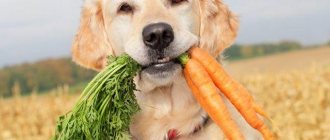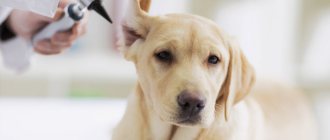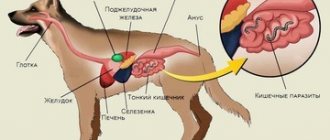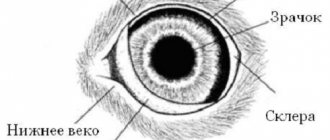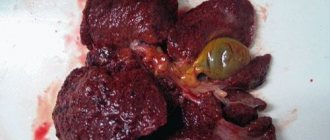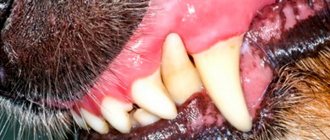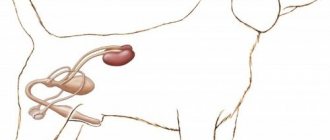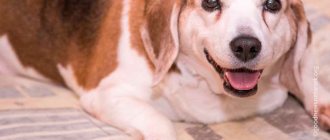Enterocolitis is an inflammatory process that develops simultaneously in the small and large intestines in dogs. Enterocolitis in veterinary practice is divided into two main forms - primary and secondary.
The primary form of enterocolitis develops as a result of nutritional disorders (the presence of spicy foods, scraps from the human table), mechanical damage (the entry of foreign objects into the digestive tract - sharp bones, as well as toxic substances).
Inflammation develops quickly, provoking the death of beneficial bacterial microflora inhabiting the large intestine. Against this background, pathogenic microorganisms become active, expanding their colonies.
Secondary form of enterocolitis . Inflammation in the thin and thick parts of the intestinal tract develops due to viral damage to the digestive system, as well as when affected by pathogenic fungal microorganisms. Parasitic infestations play an important role in the development of enterocolitis in dogs. Tumor processes and other pathological conditions can provoke inflammation.
What is this disease and who is predisposed to it?
Simultaneous inflammation of the mucous membrane of the large (colitis) and small intestine (enteritis) is called enterocolitis. The disease is divided into two forms: primary and secondary. In the first case, puppies and older dogs are more often affected.
Here are the causes of the primary form of the disease:
- improper organization of feeding (inclusion of spoiled, spicy, fried and other foods harmful to the dog in the diet);
- damage to the intestinal mucosa (entry into the gastrointestinal tract of sharp bones or other objects, toxic substances, etc.).
An inflammatory process occurs in the pet's intestines, which leads to the death of beneficial bacteria. As a result, pathogenic microorganisms actively multiply on the mucous membrane.
The secondary form is a consequence of diseases caused by viruses, bacteria, parasites or fungi. Tumors and other intestinal pathologies also lead to the development of this type of enterocolitis.
Reference. According to the course, acute and chronic forms of the disease are distinguished. In the first case, enterocolitis develops rapidly and can lead to death due to rapid dehydration of the body. The chronic form is observed in weakened and malnourished (due to poor absorption of nutrients) dogs.
Symptoms of enterocolitis in dogs
The main symptom of enterocolitis in a pet is acute diarrhea, and the stool changes as the disease progresses.
Here are the symptoms by which you can recognize the disease:
- loose stools (at first the feces have a mushy consistency with mucus, and then gradually liquefy and eventually become watery, with a noticeable admixture of blood);
- due to diarrhea, the pet’s anus becomes inflamed;
- the intestines are painful and swollen, with palpation you can hear “rumbling”;
- the pet refuses to eat, becomes lethargic and indifferent to its surroundings;
- the dog's fur becomes dull and brittle;
- Due to metabolic disorders, the animal quickly loses weight.
In the chronic form, the pet constantly produces gases and belches. Diarrhea can be replaced by constipation, and vice versa. The coat is dull and disheveled, the mucous membranes turn pale, sometimes acquiring a bluish or yellowish tint. With chronic enterocolitis, the dog periodically vomits.
Diagnosis of the disease
An accurate diagnosis can only be made by a veterinarian after examining the pet and conducting research. First of all, the animal’s blood is studied using general and biochemical analysis (sometimes the indicators remain within normal limits, anemia may be observed).
If the dog has signs of infection (high fever, blood in the stool, etc.), tests are performed for plague, enteritis, leptospirosis and other diseases. In puppies, enterocolitis is often the result of helminthic infestation, so be sure to study the pet’s feces.
To assess the condition of the intestines, ultrasound or x-rays are used (with its help, a foreign body can be detected).
Signs of enteritis in dogs and diagnostic features
The inflammatory process in the intestines of a dog is manifested by indigestion. It can manifest itself in different ways. Temperature change is not a characteristic feature. Infectious diseases are characterized by hyperthermia, but if the dog is intoxicated or the disease is accompanied by debilitating diarrhea, the temperature usually drops, often below normal.
The clinical picture depends on the form and course of the disease. Animals quickly develop primary diffuse inflammation of the intestine. The disease proceeds with the formation of various exudates - purulent, mucous, fibrinous. General signs:
- temperature increase;
- strong oppression;
- abdominal pain - manifests itself on palpation;
- appetite is reduced or may be absent.
Enteritis is characterized by vomiting. It appears after feeding. Mucus, blood and bile are often found in vomit. It is rare to detect helminths in dog vomit.
Examination reveals gray plaque on the tongue and gums. Sunken eyes, decreased skin turgor, pale skin and mucous membranes are signs of severe dehydration. By palpating the abdomen, a pronounced pain reaction is detected.
The onset of the disease is characterized by frequent bowel movements. The feces are liquid, with a lot of mucus and undigested food particles. The different impurities depend on the type of inflammatory response. There may be pus and blood present (if the small intestine is damaged, the stool becomes black).
Parvovirus enteritis in dogs is usually determined by the clinical picture. The animal has a pronounced temperature reaction, fever, and debilitating diarrhea. In addition, this disease is highly contagious among young animals, so the entire litter of puppies is often infected. Parvoviruses can be isolated from pathological material with subsequent diagnosis using PCR and ELISA, but the results have no practical impact on the treatment method.
Treatment of enterocolitis in dogs
Treatment begins with eliminating the root cause of enterocolitis (infections, the presence of parasites in the gastrointestinal tract, tumors, removal of foreign bodies from the intestines, etc.). The pet is put on a special diet.
The treatment regimen for enterocolitis is as follows (doses of drugs and duration of treatment are prescribed by a specialist):
- In case of severe dehydration, Ringer's solutions, sodium chloride, and glucose are infused intravenously (from 50 to 600 ml, depending on the size of the animal). Vitamin B12 (cyanocobalamin) or ascorbic acid is added to the solutions. If it is not possible to inject drugs into a vein, you can make subcutaneous injections into the area of the withers or shoulder blades.
- To improve digestion, medications are prescribed: Bifidum-bacterin, Prokolin, Mezim-forte, Pancreatin, Lactolisate, Liv-52, Essentiale, etc.
- To relieve pain, Imodium, Almagel, Kalmagin, Gastrofarm, etc. are used.
- After cleansing the intestines and relieving pain, the animal is given astringents: decoctions of St. John's wort, burnet, string, chamomile. Medications prescribed include activated carbon, Phospholugel, etc.
- To destroy pathogenic microflora, antibiotics are used intramuscularly: Ampicillin sodium, Penicillin, Bicillin, Kefzol, Fortum, Karitsef, etc. Among sulfonamides, tablets are used to treat dogs: Etazol, Phthalazol, Sulfadimezin, Biseptol, etc.
- If parasites are present, Furazolidone, Piperazine, Decaris are prescribed (once).
- To stimulate the immune system, immunostimulants are used: Timalin, Interferon, Immunoglobulin, Lactoglobulin.
- To relieve intestinal spasms, Smazmolitin, No-Shpu, Baralgin, Aminazin, etc. are prescribed.
- To relieve or prevent allergies, use Suprastin, Fenkarol, Tavegil, solutions of calcium chlorine or gluconate.
Attention. Be sure to give your dog access to a water bowl. You can add infusions of medicinal plants to your drink (they relieve inflammation and have enveloping and astringent properties): string, sage, oak bark, licorice, chamomile, St. John's wort, flaxseed, burnet, etc.
Treatment
Let's look at various treatment regimens for intestinal inflammation in dogs.
How to treat intestinal inflammation in a dog?
Antibiotics
The first “healer” for the intestines is a group of broad-spectrum antibiotics that kill pathogenic microflora localized in the intestines.
As such a remedy, you can use the drug “ Levomycetin ”. By feeding a large (10+) dog 1/4 tablet 2 times a day, and a small dog 1/6 tablet, the result can be seen the very next day. However, this does not mean that treatment can be stopped. The course of antibiotic therapy should last at least 5–6 days.
Levomycetin fights pathogenic microflora.
Nitrofuran
Of this group of drugs, furazolidone is the most harmless and quite effective.
The drug can cope with intestinal pathogenic microflora, fungi and protozoa, which is why it is successfully used in dog breeding farms.
Furazolidone copes with protozoa in the intestinal microflora.
Dosing 3-5 mg/kg of body weight and mixing with food, the drug must be given for 7-9 days .
Anthelmintics
If the cause of inflammation is nematodes or coccidia, and the pathogenic microflora is secondary, then chloramphenicol will help for a while, and then the situation will repeat. In this case, it is necessary to use the Procox oral suspension. It will kill both roundworms and coccidia.
Procox will help get rid of roundworms.
If there is no veterinary drug at hand, you can use sulfademitoxin, which is good for isosporiasis. In this case, the dose must be maintained at 20–25 mg/kg of the dog’s weight and the drug must be administered for 10 days.
If segments of cucumber tapeworm (dipylidia) , then you cannot do without canikquantel or drontal.
Diet for enterocolitis
On the first day after diagnosis, the pet is not fed, but water with the addition of medicinal decoctions should be freely available. Every other day, the dog is fed raw eggs (2-3 pieces per day).
On day 3-4, start feeding your pet liquid oatmeal or rice porridge cooked in water. You can add a couple of tablespoons of boiled minced meat (beef or chicken) to it. The first portions should be small (1-2 spoons), then they are increased (if there is no reaction in the form of diarrhea or vomiting).
Prevention
Prevention of enterocolitis is as follows:
- feed your dog correctly, exclude tubular and other sharp bones, spicy and fried foods from the diet;
- do not allow your pet to pick up food on the street (it may be spoiled or poisoned);
- do not forget to worm your dog (every 3-4 months);
- Vaccinate your pet every year against infectious diseases (plague, enteritis, etc.).
Enterocolitis is a disease caused by inflammation of the intestines. It is important to start treatment on time, as the disease can become chronic. If your pet feels unwell and his stool has become runny, contact your veterinarian as soon as possible. Dehydration is dangerous for the body!
Enterocolitis in dogs: signs, symptoms and treatment methods
Diseases associated with intestinal dysfunction are not uncommon in our time. The reasons may be different, in some cases it is the result of eating bad food, in others it is the effect of parasites. In this article we will look at a disease that occurs among our four-legged friends, which is called enterocolitis in dogs . This is an inflammation of the intestines that combines the presence of two diseases - enteritis and colitis.
We will try to convey to you as much information as possible about what enterocolitis is in dogs, we will tell you about the symptoms and treatment.
Enterocolitis in dogs: causes
Since enterocolitis in dogs is a disease directly related to the gastrointestinal tract , the causes of its occurrence must be sought based on the pathologies of this organ. N
- Below are the main factors that can influence the appearance of intestinal inflammation in a dog :
- infection of the gastrointestinal tract is a very good reason for the presence of inflammation. Intestinal diseases can be divided into two groups. One is the effect of viruses, the second is the consequences of bacterial activity. In the first case, an unvaccinated dog may become infected; in the second case, the cause of the disease may be salmonellosis;
- parasitic diseases - there are a lot of microorganisms that can adversely affect the state of the intestinal microflora. A dog, due to its animal characteristics, can easily pick up worms or giardia by interacting with the environment;
- poisoning – a pet can be poisoned not only by food, but also by household chemicals, which are often freely available. Also, various toys that are processed or contain chemicals, once in the intestines, will provoke inflammation;
- cancer is an important factor that can cause enterocolitis in your pet;
- decreased immunity – pathologies of immune cells weaken the body’s defenses and can provoke the onset of disease;
- complication of the disease - it is worth mentioning that enterocolitis often appears against the background of other diseases of the gastrointestinal tract.
Knowing the causes of enterocolitis in your pet, you can take measures to exclude or prevent the formation of the disease.
Prevention of enterocolitis
First of all, prevention consists of selecting a dog that is appropriate for the age and health of the dog. If the animal consumes natural products, then it is worth giving up fatty meat and fish and giving preference to broths that are easily absorbed by the body.
Timely vaccinations will protect your dog from a number of infections and bacteria that cause intestinal inflammation.
It is necessary to monitor the dog during a walk, you should not allow the animal to dig through garbage cans, it is not advisable to allow it to come into contact with other animals, they can be carriers of diseases.
Prevention will reduce the risk of enterocolitis, and it is easier to prevent any illness than to treat it later.
Characteristic. Inflammation of the mucous membrane of the small intestines - enteritis and the large intestine - colitis. It usually occurs simultaneously.
Etiology. As a primary disease, enterocolitis is rare due to improper feeding and predisposition to allergies in shepherd dogs. In most cases, intestinal inflammation occurs as a secondary process in acute infections, invasive and protozoal diseases, poisoning with heavy metal salts, tumor lesions of the intestinal wall and a number of other pathologies.
Symptoms. Clinically, intestinal disease is always accompanied by diarrhea. In this case, the stool initially has a mushy consistency, mixed with mucus, then becomes watery, containing blood. Severe diarrhea always occurs with tenesmus, and there is a danger of rectal prolapse. Sometimes inflammation of the anus develops, then the dog vigorously licks this area, sits on the ground and, moving as if “on a sled,” rubs the tissue. Palpation reveals slight rigidity of the abdominal wall, pain and “rumbling” in the intestines, and auscultation reveals increased peristaltic noise.
X-ray During fluoroscopy of the intestine, accelerated passage of contrast masses and a tendency of muscle tissue to spasms are noted. Changes in blood status depend on the severity of the disease.
Summary clinic: 1. Anorexia (lack of appetite, refusal to eat); 2. Ascites, accumulation of fluid in the abdominal cavity; 3. Auscultation of the heart: muffled, decreased heart sounds; 4. Auscultation: Reduced, dull pulmonary sounds, absence of sounds; 5. Pallor of visible mucous membranes; 6. Pain on deep palpation of the abdomen; 7. Tousled fur; 8. Hematemesis: presence of blood in vomit; 9. Hepatosplenomegaly, splenomegaly, hepatomegaly; 10. Dehydration, 11. Diarrhea, diarrhea; 12. Diarrhea: mucous; 13. Dyspnea (difficulty breathing, with an open mouth); 14. Perverted appetite; 15. Intra-abdominal masses; 16. Exhaustion, cachexia, unkemptness; 17. Colic, abdominal pain; 18. Bloody feces, hematochezia; 19. Xerostomia, dry mouth; 20. Lymphadenopathy; 21. Fever, pathological hyperthermia; 22. Melena, black stool; 23. Unusual or foul-smelling stool; 24. Bad breath, Halitosis; 25. Swelling of the skin; 26. Polydipsia, increased thirst; 27. Polyuria, increased volume of urination; 28. Polyphagia, extremely increased appetite; 29. Loss of body weight; 30. Vomiting, regurgitation, emesis; 31. Steatorrhea, fat in stool; 32. Tachycardia, increased heart rate; 33. Tachypnea, increased respiratory rate, polypnea, hyperpnea; 34. Tenesmus. pushing; 35. Enlarged borborygms, flatulence; 36. Depression (depression, lethargy)
Development. Due to the variety of factors that determine the development of enterocolitis, it is not always possible to correctly diagnose the disease and carry out timely specific treatment. As a result, acute forms of the disease become chronic. In this case, inflammatory changes in the intestinal mucosa decrease, but secretory-motor disorders increase.
The prognosis depends on the underlying disease.
Treatment. Firstly, especially with acute catarrh, the animal is denied food for 1-2 days, giving unlimited water and small portions of tea. In the following days, oatmeal broth and minced meat are allowed to be given little by little. Milk, sugar, eggs, fat and bones are contraindicated. Drug treatment begins with cleansing the gastrointestinal tract. For this, castor oil is prescribed 1-3 tablespoons inside. If the inflammation is localized in the large intestine, then a deep enema (water with hydrogen peroxide) is preferable. The further treatment plan is built in accordance with the differential diagnosis: antibacterial therapy - antibiotics (kanamycin, chloramphenicol) and chemotherapy drugs (Biseptol, Intestopan). If nephritis is detected and leptospirosis is suspected in this regard, 4-fold administration of penicillin with streptomycin is prescribed to treat the latter.
In case of chronic enterocolitis, it is especially important to follow a diet for a long time (1-2 months) and replenish fluid in the body. The nature of drug therapy should be more than a restorative plan.
Since enterocolitis in dogs is a disease directly related to the gastrointestinal tract
, the reasons for its appearance must be sought based on the pathologies of this organ. N
Knowing the reasons for the appearance
enterocolitis in your pet, you can take measures to exclude or prevent the formation of the disease.
Enterocolitis in dogs: symptoms
The presence of malfunctions in the body is manifested by changes in the animal’s behavior, which are easy to notice.
The following are
the main symptoms of enterocolitis :
If you notice one of the following symptoms in your dog, you need to call a veterinarian. Under no circumstances should you self-diagnose the disease, much less self-medicate. The actions of non-professionals can only harm the animal by causing complications or deterioration of the general condition.
Intestinal inflammation in dogs: symptoms and treatment features
12.04.2018
Gastrointestinal diseases in dogs are a fairly serious illness. These diseases bring inconvenience not only to the pet, but also to the owner himself. Nevertheless, it is quite possible to contact a veterinarian in a timely manner with such a problem and successfully solve it.
What diseases are considered to be gastrointestinal diseases?
Gastrointestinal diseases are diseases in which so-called inflammatory cells—cells produced in the body by wounds or injuries—invade the animal’s stomach and intestines. These include 2 groups of cells. This:
- Lymphocytes and plasmacytes are cells responsible for the body's immune responses.
- Eosinophils and neutrophils are cells responsible for cleaning damaged tissue.
With chronic inflammation, normal tissue can be replaced by fibrous (scar-like) tissue.
Causes of gastrointestinal diseases in cats
The exact causes of this type of disease in cats are unknown. Genetic predisposition, nutrition, various infections, and a malfunction of the immune system can all play a role. Inflammation of the gastrointestinal tract may not be a disease as such, but a characteristic reaction of the body to certain conditions caused by various factors.
The types of cells that invade the intestines determine the form of inflammatory disease.
Symptoms of intestinal diseases in dogs
The following symptoms are typical for intestinal diseases in dogs:
- diarrhea and vomiting, occurring depending on the area of damage to the gastrointestinal tract. Damage to the stomach and upper small intestine causes vomiting, and the large intestine causes diarrhea;
- sometimes stools become more frequent, but each time it becomes less and less;
- mucus and blood often appear in the stool;
- in severe cases, the animal is depressed, refuses to eat, loses weight, and develops a fever.
In some dogs, the only symptoms of intestinal inflammation are bloody stools or weight loss. Others stop using the tray when defecating.
Diagnosis of gastrointestinal diseases in cats
- Gastrointestinal diseases in dogs are characterized by a chronic course, as well as the inflammatory nature of the lesions. When making a diagnosis, reasons for the introduction of inflammatory cells such as the presence of parasites or bacterial infection must be excluded.
- Your veterinarian may suspect an inflammatory gastrointestinal disease if your pet has been vomiting, having diarrhea, or having mucus or blood in the stool for an extended period of time.
- Upon examination, the animal looks thin; in some dogs, a thickened intestine can be felt.
- Laboratory tests usually show nothing. With very serious inflammation, damage can affect neighboring organs - the liver and pancreas.
- As a result, the body increases the content of liver enzymes and amylase, which is produced by the pancreas.
- There may be a decrease in protein levels in the blood, and with severe vomiting, there may be a decrease in the level of electrolytes, especially potassium.
In most cases, blood tests are normal, although anemia may sometimes develop. Some animals have eosinophils in their blood.
X-ray and ultrasound examinations usually do not provide any information. Sometimes thickening of the intestines and accumulation of gas may be noticeable, but this happens with many diseases.
The only way to diagnose inflammatory gastrointestinal disease is through a biopsy.
- It will show the presence of an increased number of inflammatory cells in the walls of the small intestine and the type of these cells.
- A biopsy will reveal microscopic changes in tissue that are not visible to the naked eye. In other diseases, damage to the gastrointestinal tract is quite obvious.
- When making a diagnosis, other causes of diarrhea and the appearance of infiltrates must be excluded. A stool test should rule out parasites, and the results of a blood test should rule out diseases such as hyperthyroidism, liver disease, and infection with the canine leukemia virus.
Treatment of gastrointestinal diseases in dogs
Treatment for gastrointestinal diseases in dogs usually consists of various diets and medications.
Diet. At the first stage of treatment, a food test is needed - the use of hypoallergenic foods, sources of protein and carbohydrates that the animal has not previously eaten, for example, duck and potatoes. The animal should not eat anything else and not take any medications. This test should continue for 2-3 months.
If the animal’s health does not improve with such a diet, then you need to try other products.
- If the disease mainly affects the large intestine, it is useful to feed food rich in fiber. You can add oat bran to the food. If the lesion has affected the small intestine, some animals may benefit from being given a highly digestible, low-fiber diet. Low-gluten carbohydrates are also beneficial.
- Do not feed food containing wheat, oats, rye or barley. Sometimes the animal is fed natural homemade food, but this is rarely balanced, and therefore commercial food is preferable for a long period of time.
- Treatment with medications. Various medications are used to reduce the number of inflammatory cells.
- Azathioprine and cyclophosphamide: These medications suppress the immune system and are usually used only if other treatments have failed or in combination with corticosteroids.
- These medications may have a negative effect on bone marrow function, so close monitoring and regular blood tests are recommended when using them.
Source:
How to treat intestinal inflammation in a dog?
Intestinal inflammation in dogs, the symptoms and treatment of which we will discuss in this article, is inextricably linked with frequent vomiting. But there are other factors by which the occurrence of gastroenteritis can be determined.
Source: https://zoomak.ru/sobaki/vospalenie-kishechnika-u-sobaki-simptomy-i-lechenie.html
How is enterocolitis diagnosed in dogs?
Before prescribing treatment, the doctor must carry out a series of diagnostic measures to establish the exact cause.
and make a diagnosis.
Enterocolitis is similar in its symptoms to other diseases
, therefore, in order to avoid errors when making a diagnosis, the professionalism of a veterinarian is very important. Our veterinary office offers the services of only qualified specialists whose activities are documented.
- Below are the main examinations prescribed by a veterinarian to diagnose enterocolitis in dogs:
Enterocolitis in dogs: causes and symptoms of the disease, diagnosis and treatment
Enterocolitis is an inflammatory process that develops simultaneously in the small and large intestines in dogs. Enterocolitis in veterinary practice is divided into two main forms - primary and secondary.
The primary form of enterocolitis develops as a result of nutritional disorders (the presence of spicy foods, scraps from the human table), mechanical damage (the entry of foreign objects into the digestive tract - sharp bones, as well as toxic substances).
Inflammation develops quickly, provoking the death of beneficial bacterial microflora inhabiting the large intestine. Against this background, pathogenic microorganisms become active, expanding their colonies.
Secondary form of enterocolitis . Inflammation in the thin and thick parts of the intestinal tract develops due to viral damage to the digestive system, as well as when affected by pathogenic fungal microorganisms. Parasitic infestations play an important role in the development of enterocolitis in dogs. Tumor processes and other pathological conditions can provoke inflammation.
Types of disease and its manifestation
Colitis and enteritis in their manifestations are divided into primary and secondary forms. Enterocolitis in its primary manifestation is more often diagnosed in puppies; in older dogs, a secondary form of pathology is detected in the presence of gastrointestinal diseases.
The causes of the development of enterocolitis are different, most often inflammation of the large and small intestines is provoked by viruses, foreign bodies (traumatic enterocolitis in dogs), poisoning and allergens.
Classification:
Enterocolitis can be distinguished by a number of specific pathologies.
Causes of the disease
Intestinal enterocolitis in dogs is manifested by an inflammatory process in the walls of the entire intestinal tract. Pathogenic bacterial microflora, as a result of their activity, provokes the onset of necrosis of the mucous membrane and the development of allergic-type reactions.
The most commonly diagnosed bacterial enterocolitis in dogs. Their development is provoked by poor quality nutrition. A dog fed low-quality food can easily contract salmonellosis. Also, the development of colitis and enteritis in combination is provoked by viral infections.
In the absence of timely vaccination, dogs suffer from parvovirus enteritis, which affects the entire digestive tract, and often provokes the rapid martyrdom of the pet.
Other provoking factors for enterocolitis include:
- Helminthiasis . Parasitic infestations are also common among canids. Dogs come into contact with various objects, trying to sniff and lick them, becoming infected with parasites. In addition to the usual tapeworms, the domestic dog’s body is affected by giardiasis and echinococcosis, especially when eating suspicious offal and unheated meat.
- Serious intoxication of the body provokes irritation of the intestinal mucosa, causing an inflammatory process.
- Neoplasms of malignant and benign nature.
- Pathological changes in the dog’s body’s immunity.
Causes of intestinal inflammation
The intestinal mucosa faces a variety of impacts, second only to the skin in this regard. At the same time, the protective mechanisms of the intestine are significantly weaker. Enterocolitis in dogs can be associated with a variety of reasons:
- nutritional factors - poor quality food, hot or cold, irregular feeding, presence of irritating and toxic substances in food;
- infectious and invasive causes;
- primary diseases (hepatitis, pneumonia, pancreatitis);
- intestinal defects (blockage, vascular ischemia, tumors);
- pathology of neuroendocrine regulation.
The main etiological factor leading to an inflammatory reaction in the intestines is feeding, or rather errors in it. It has now become widely popular to use ready-made commercial food for dog nutrition - dry, wet canned food. Not every one of these products is suitable for long-term feeding - they are made from low-quality raw materials, and to improve their consumption they are saturated with various flavor enhancers.
Equally bad for the intestines is “food from the table” - the traditional way of getting rid of leftover food. Dogs are given boiled bones, food with plenty of salt and pepper, and various sweets. Spicy, rough food leads to irritation of the mucous membrane; chicken bones can injure the intestinal walls. As a result, ideal conditions are formed for the development of pathogenic microflora.
A hereditary predisposition to ulcerative colitis has been identified in boxers.
Bacteria and viruses are an essential component of intestinal inflammation. If they did not cause enteritis, they certainly complicated it. Mechanical damage to the intestines and trauma by parasites leads to the development of a gateway for infection. In addition, diseases such as leptospirosis, colibacillosis, pasteurellosis, parvovirus enteritis, and salmonellosis have a direct effect on the intestines. As a result, beneficial microflora is replaced
Mechanism of development of enterocolitis:
- exposure to a pathogenic factor;
- inflammatory response, degenerative processes;
- suppression of gland function and absorption - digestion is disrupted;
- the lack of enzymes increases - fermentation occurs in the intestines;
- the protective function of the intestinal mucosa is suppressed, resistance decreases;
- most of the beneficial microflora is reduced;
- intestinal motor function is impaired;
- decomposition products accumulate - indole, skatole, and the body is poisoned.
Enterocolitis can develop against the background of other diseases. Most intestinal lesions lead to inflammatory reactions: neoplasms, volvulus and pinched loops, vascular infarction. Diseases and systemic non-contagious pathologies contribute - liver cirrhosis and hepatitis, metabolic disorders, pneumonia and bronchitis.
Symptoms of enterocolitis
Symptoms of the disease in dogs are quite typical. The severity of the signs of enterocolitis depends on the stage and state of the body’s immune forces, as well as the factors that provoked the inflammatory process.
If the cause of the disease is a viral infection, hemorrhagic enterocolitis develops in dogs, which is characterized by nausea, vomiting and severe diarrhea with blood. Dehydration occurs a few days after the onset of symptoms. Without timely treatment, the dog dies, especially for puppies.
The basic signs of the acute stage of enterocolitis are:
- Eruption of gastric contents (vomiting);
- false urge to defecate;
- profuse diarrhea mixed with mucus and blood;
- rectal prolapse (with severe and frequent diarrhea);
- weight loss (observed with chronic enterocolitis in dogs);
- change in coat quality;
- pain in the abdominal area;
- febrile conditions in dogs due to loss of strength.
In addition to general signs, enterocolitis in dogs is manifested by lethargy and apathy. The pet refuses to eat and does not want to take long walks. Systemic chronic diseases and individual characteristics of the dog, for example food or idiopathic allergies, can complicate the course of the pathology.
Differential diagnostic methods
Sick pets are in a severely depressed state with a weak reaction to external stimuli. Feed consumption is reduced, and appetite is often completely absent. The change in temperature depends on the etiological factor that caused the inflammation - with toxic enteritis there is a decrease in temperature, and with others - an increase.
The clinical picture is especially pronounced in acute forms of hemorrhagic, fibrinous or purulent enterocolitis:
- temperature increased by 1-2 degrees;
- severe depression, the dog constantly lies down;
- severe pain reaction, colic in dogs;
- there is no reaction to food;
- vomiting with blood, mucus, bile;
- debilitating diarrhea;
- liquid stool may contain fibrin, pus, blood - depends on the type of inflammation;
- white and gray coating on the tongue and oral mucosa;
- turgor is reduced, mucous membranes are pale, eyes are sunken, and other signs of dehydration appear.
Palpation reveals severe pain, the abdominal wall is tense. The intestinal loops are motionless, inelastic, and painful. The surface of the body is cold, this is especially pronounced at the tip of the nose, tail, paws and ears.
To clarify the diagnosis, laboratory tests are carried out - primary bacterial and viral diseases and invasive pathologies should be excluded. When examining stool, a large amount of undigested food, an increased content of fatty acids, mucus and blood are found.
Changes in the blood:
- hematocrit is increased;
- leukocytosis with a shift to the left;
- increased urea content;
- increased activity of liver enzymes.
Diagnostics
Treatment of inflammation of the small and large intestines does not begin without establishing the exact provoking cause.
Making a diagnosis in a veterinary clinic includes the use of laboratory and instrumental techniques. An anamnesis is collected and the necessary tests are prescribed - a biochemical panel (necessary to assess the functioning of the hepatorenal system and pancreatic structures, determine the level of sugar in the bloodstream), a general clinical blood test (important to determine or refute bacterial inflammatory factors.
Electrolyte tests are used to determine the degree of dehydration in a dog's body. Visualization of the pathological process is carried out by performing radiographic and ultrasound examinations. To exclude the presence of a foreign body in the intestines of dogs, X-rays using a contrast agent can be used. Ultrasound diagnostics is also necessary to assess the integrity of the walls and timely detection of possible perforations.
Research using an endoscope (a special tube with a camera) makes it possible to assess the condition of the inner walls of the inflamed large and small intestines. Endoscopy is also necessary for taking samples from the affected intestinal walls and further performing a biopsy.
The presence of helminthic infestations can be ruled out by stool analysis. Of the special studies carried out exclusively in severe situations, when the above methods failed to identify the cause, sowing cultures on nutrient media, polymerase chain reaction, and enzyme immunoassay are used.
In advanced cases, when the animal’s condition is critical, before carrying out diagnostic measures, a specialist carries out emergency treatment without identifying the cause of the inflammation. Attacks of vomiting are stopped, intravenous infusions of saline and glucose are given to support the body, and diarrhea is also stopped. When the dog’s condition returns to normal, the veterinarian begins diagnostics.
Establishing diagnosis
Ultrasound examination of a dog's intestines.
The diagnosis cannot be made on the basis of any one sign. Only a comprehensive study, including laboratory research, can reveal the true cause and prescribe the correct treatment.
A diagnosis is made based on a comprehensive study.
If it is not possible to contact a qualified specialist, and the dog needs urgent help, you must resort to the drugs available in the emergency veterinary kit.
Treatment and prevention of enterocolitis
Treatment and a special diet are necessary to eliminate the inflammatory process in the large and small intestines. Without timely consultation with a doctor, the dog develops serious complications that threaten the pet’s life. Once the factor that provoked the disease is determined, a treatment regimen is developed. The therapeutic course scheme is as follows:
- Prevention of severe dehydration is carried out by administering glucose and Ringer-Locke solutions. Cyanocobalamin or vitamin B12, as well as vitamin C, are often added to the solution.
- Improving the quality of food absorption - prescribing medications based on enzymatic substances (Lactolisate, Prokolin, Mezim).
- Elimination of pain and discomfort in the intestinal area with special means (Almagel, Gastrofarm).
- The use of astringents, which can also reduce pain in the intestines with enterocolitis. Decoctions of medicinal plants - chamomile, St. John's wort - are widely used.
- Antibacterial therapy to destroy foreign microflora. General drugs are used - Etazol, Bicillin, Fortum, Sulfadimezin.
- Elimination of spasms in the intestines is achieved by administering antispasmodics - No-Shpa, Spasmolitin.
In case of allergic reactions that provoke the development of enterocolitis in dogs, hormonal therapy is carried out. It is necessary to administer immunomodulatory drugs to the animal to increase the body's defenses in the fight against inflammation.
Nutrition during treatment
Treatment of chronic enterocolitis in dogs comes down to preventing the exacerbation phase. The basis of treatment for the chronic form of the disease is a proper diet. The pet should be given liquid porridge boiled in water. You can add boiled ground beef or chicken to the porridge.
Feeding a dog with chronic enterocolitis should be small and frequent. Fermented milk products, boiled or steamed vegetables are added to the diet. There are also ready-made diets designed for sick animals. Ready-made food should be selected by a veterinarian. It is recommended to choose super-premium and holistic food.
Prevention
In order to prevent the development of enterocolitis in dogs, it is necessary to follow a number of simple rules. The pet owner must monitor the quality of the diet - do not feed sharp bones, fried or salty foods. It is prohibited to allow animals to eat food picked up on the street. It is necessary to regularly carry out antiparasitic treatment and vaccinate your pet.
Enterocolitis in the acute stage, if not treated in a timely manner, becomes chronic. It is important to prevent the development of complications and if characteristic signs of inflammation appear in the large and small intestines, contact a veterinary clinic for advice.
Sources:
https://sobaki-pesiki.ru/enterokolit-u-sobak.html https://ya-vet.com/gastroenterolog/enterokolit-u-sobaki-simptomy-i-lecheniya https://animals-world.ru/ enterokolit-u-sobak/

